Welcome to a new Challenge
So we took on this new challenge from our pals, the Social Engineering Experts. Gotta admit, it was pretty tough - I mean, they’re experts, right?
babyreeee
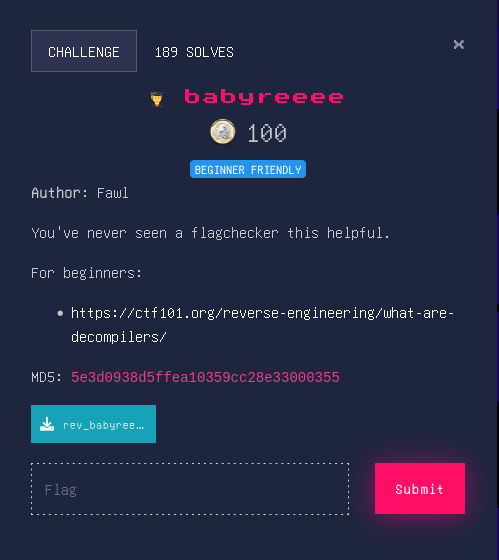
So based on the description, it looks like this binary just checks if we’ve got the right flag. We loaded it up in ghidra, which gave us some pretty sweet insights already:
Disclaimer: You should never execute something if you don’t know what it does. But hey, we’re rebels, so who cares, right? What’s the worst that could happen?
uStack44 = 0x5e; //more values loaded into the stack above
local_28 = 0x50;
uStack36 = 0x86;
uStack32 = 0x89;
uStack28 = 0x89;
local_18 = 0x48;
uStack20 = 0x4f;
uStack16 = 0x49;
uStack12 = 0xf1;
fgets(local_158,0x80,stdin); //here we get asked for our input
sVar4 = strlen(local_158); // gets the length of our input
if (sVar4 == 0x35) { // 0x35 in decimal is 53 , since we put \n as our input by pressing enter we are searching for a 52 length value
puts(“Good work! Your flag is the correct size.”);
puts(“On to the flag check itself…”);
sVar4 = strlen(local_158);
uVar5 = 0;
do {
uVar6 = uVar5 & 0xffffffff;
if (sVar4 - 1 == uVar5) {
puts("Success! Go get your points, champ.");
return 0;
}
pcVar1 = local_158 + uVar5; // loads our input
puVar2 = local_d8 + uVar5; // loads a value from above
bVar3 = (byte)uVar5;
uVar5 = uVar5 + 1;
} while ((byte)puVar2 == (byte)(pcVar1 + 0x45U ^ bVar3)); // does a check if the input we gave after transformation is equal to the loaded value
printf(“Flag check failed at index: %d”,uVar6);
}
else {
printf(“Flag wrong. Try again.”);
}
return 1;
}
- Let’s figure out what to do
So apparently, some smart cookies managed to convert (byte)(*pcVar1 + 0x45U ^ bVar3)) into a simple script and let it work its magic. But we took a different approach here:
printf(“Flag check failed at index: %d”,uVar6);
So every time the input doesn’t match the right value, the program tells us the index value of the error. This little tidbit of information can be used as a checker to verify if the input is correct, and if it is, move on to the next value. It really cuts down the time needed for a brute-force attack. And that’s exactly what we did:
#!/usr/bin/python
from pwn import *
from string import ascii_lowercase,ascii_uppercase,digits
checksolution = ("Success! Go get your points, champ.\n").encode('utf-8')
elf = ELF('./rev_babyreeee')
#We know that the flag starts with SEE{ and that the flag is in the format SEE{[ -~]+} plus ascii signs
current_flag = "SEE{"
old_flag = ""
index = 4
checklist = ascii_uppercase + ascii_lowercase + digits + "_}"
while current_flag != old_flag:
missingvar = 51 - len(current_flag) #this is the amount of characters we have to find
for c in checklist:
io = elf.process()
print(io.recvline(timeout=2))
#this block here is to send the current sign of the flag to the binary and check the response
sendvar = (current_flag + c + "A" * missingvar ).encode('utf-8')
io.sendline(sendvar)
print(sendvar)
print(io.recvline(timeout=2))
print(io.recvline(timeout=2))
checkvar = io.recvall(timeout=2)
checktest = ("Flag check failed at index: {}".format(index)).encode('utf-8')
print(checkvar)
print(checktest)
#to check if we found the solution
if checkvar == checksolution:
current_flag = current_flag + c
print(current_flag)
old_flag = current_flag
break
else:
print("next please")
#check if we found the next correct character
if checkvar != checktest:
print(current_flag)
old_flag = current_flag
current_flag = current_flag + c
break
else:
print("i said next")
io.close()
#was my error checker to ensure the script comes to an end
if c == "}":
print("shit")
old_flag = current_flag
break
index += 1
print("welcome to the end")
print(current_flag)
- Execute the exploit
So the FLAG is SEE{0n3_5m411_573p_81d215e8b81ae10f1c08168207fba396}
On our system, it didn’t take too long to brute force the flag, so we were able to pull it off during the challenge. It may not be the prettiest script in the world, but it did the job, and who knows, maybe it was even an unintentional solution for the creators of the CTF. Sometimes you just have to fall back on the old ways of cracking things ¯\_(ツ)_/¯. Nonetheless, it was a pretty neat challenge.
- Do the happy dance
ヾ( ͝° ͜ʖ͡°)ノ♪ ヾ( ͝° ͜ʖ͡°)ノ♪ ヾ( ͝° ͜ʖ͡°)ノ♪
Best Software
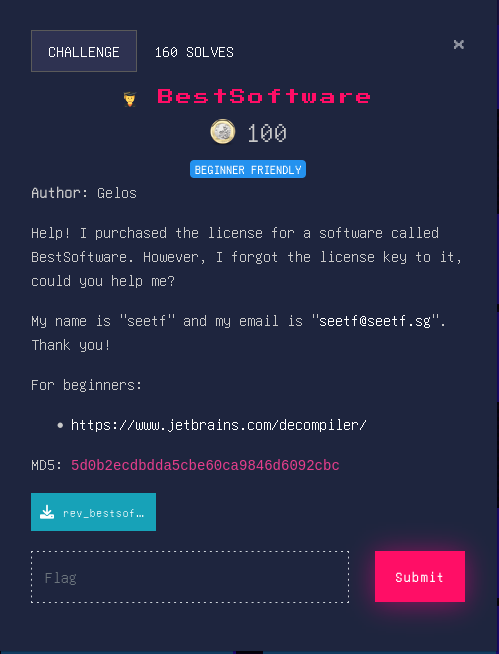
This time around, we had to help our buddy Gelos get the license key for the best software around. At first glance, we noticed that we had an .exe file, so we ran “file” on it to get some more information:
└─$ file BestSoftware.exe
BestSoftware.exe: PE32 executable (console) Intel 80386 Mono/.Net assembly, for MS Windows
Haha, a good old .Net executable (ー ー;)! Since we didn’t have a Windows system handy, we had to set up our Linux distro first to work on this. Here’s what we needed:
- A way to execute the binary
- Inspect the PE
- Get the Flag
The easiest solution would have been to just spin up Windows, but we found some workarounds for each problem:
- A way to execute the binary -> install mono for it. We used the mono-complete based on the description to ensure that everything works mono
- Inspect the PE -> We found a neat github project to bring ILSpy to Linux. Worked flawlessly AvaloniaILSpy
- Get the Flag -> thats the next part
Alright, with our setup complete, it was time to take a look at the file with ILSpy.
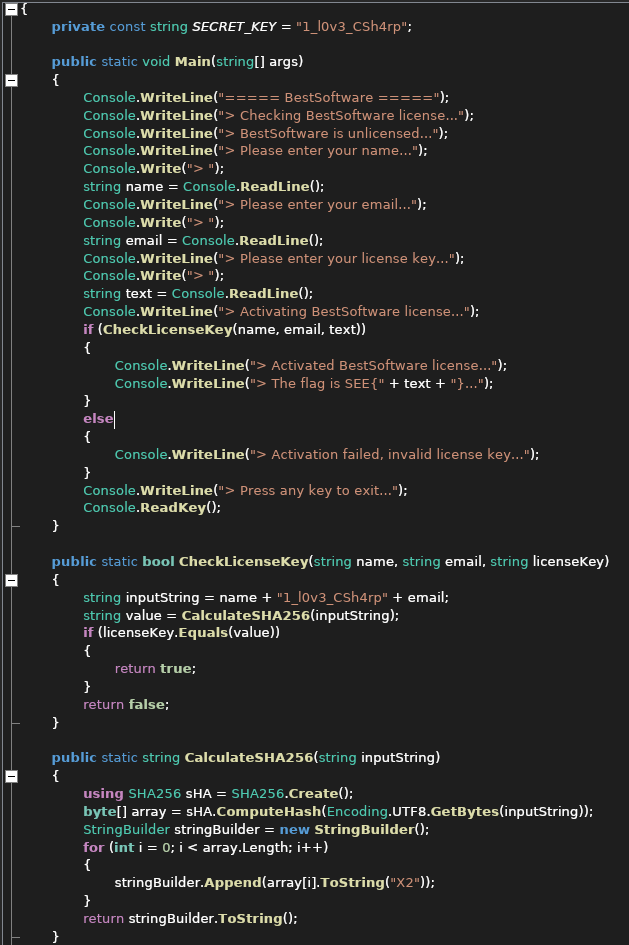
Now we can see that the program is not too much of a hassle to go through. In the main function, we are asked to provide our name,email and a license key. Then, the function CheckLicenseKey is called with our input as an argument, which checks if the SHA256 hash of our name + “1_l0v3_CSh4rp” + email matches the expected license key. We can calculate the SHA256 hash of our input using the function CalculateSHA256, and this will give us the license key we need to complete the challenge.
For that, we simply copied all the code we had into an online .Net compiler and modified the main function to output the license key instead of checking it. Then we ran the program and got the license key. We called it the Keygenerator for the Best Software. It was a simple solution, but it got the job done.
Disclaimer: Never execute something you don’t know. So maybe not the best habit to have. But what could possibly go wrong?
using System;
using System.Security.Cryptography;
using System.Text;
internal class Program
{
private const string SECRET_KEY = "1_l0v3_CSh4rp";
public static void Main()
{
Console.WriteLine("===== BestSoftware Keygenerator =====");
Console.WriteLine("> Checking if you are from the police");
Console.WriteLine("> (ㆁᴗㆁ✿)");
Console.WriteLine("> (✿ㆁᴗㆁ)");
Console.WriteLine("> Please enter your name...");
Console.Write("> ");
string name = Console.ReadLine();
Console.WriteLine("> Please enter your email...");
Console.Write("> ");
string email = Console.ReadLine();
Console.WriteLine("> Creating BestSoftware license...");
string inputString = name + "1_l0v3_CSh4rp" + email;
string value = CalculateSHA256(inputString);
Console.WriteLine("> The key is " + value + " now go go");
Console.WriteLine("> Press any key to run...");
Console.ReadKey();
}
public static string CalculateSHA256(string inputString)
{
using SHA256 sHA = SHA256.Create();
byte[] array = sHA.ComputeHash(Encoding.UTF8.GetBytes(inputString));
StringBuilder stringBuilder = new StringBuilder();
for (int i = 0; i < array.Length; i++)
{
stringBuilder.Append(array[i].ToString("X2"));
}
return stringBuilder.ToString();
}
}
Sure, every great software should have also a great Keygenerator. So with the given name and email the Flag is: SEE{28F313A48C1282DF95E07BCEF466D19517587BCAB4F7A78532FA54AC6708444E} . Again I think the reverse challenges are done by us not the way they should be.
- Get the Flag
we did it ヾ(๑ ³ㅿ³)ノ onto the next one
Wayyang
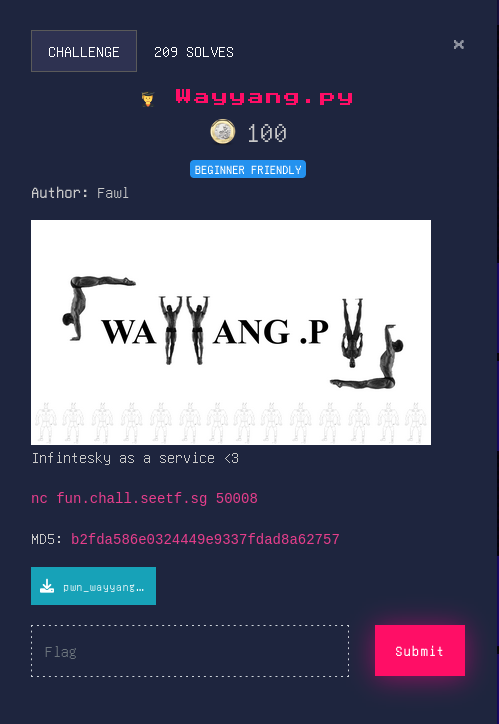
So this time we got a little python script:
#!/usr/local/bin/python
import os
FLAG_FILE = "FLAG"
def get_input() -> int:
print(''' ,#####,
#_ _#
|a` `a|
| u | ________________________
\ = / | WAYYANG |
|\___/| < TERMINAL v1.0 |
___ ____/: :\____ ___ |________________________|
.' `.-===-\ /-===-.` '.
/ .-"""""-.-"""""-. \
/' =:= '\
.' ' .: o -=:=- o :. ' `.
(.' /'. '-.....-'-.....-' .'\ '.)
/' ._/ ". --:-- ." \_. '\
| .'| ". ---:--- ." |'. |
| : | | ---:--- | | : |
\ : | |_____._____| | : /
/ ( |----|------| ) \
/... .| | | | |. ...\
|::::/'' jgs / | \ ''\::::|
'"""" /' .L_ `\ """"'
/'-.,__/` `\__..-'\
; / \ ;
: / \ |
| / \. |
|`../ | ,/
( _ ) | _)
| | | |
|___| \___|
:===| |==|
\ / |__|
/\/\ /"""`8.__
|oo| \__.//___)
|==|
\__/''')
print("What would you like to do today?")
print("1. Weather")
print("2. Time")
print("3. Tiktok of the day")
print("4. Read straits times")
print("5. Get flag")
print("6. Exit")
choice = int(input(">> "))
return choice
if __name__ == '__main__':
choice = get_input()
if choice == 1:
print("CLEAR SKIES FOR HANDSOME MEN")
elif choice == 2:
print("IT'S ALWAYS SEXY TIME")
elif choice == 3:
print("https://www.tiktok.com/@benawad/video/7039054021797252399")
elif choice == 4:
filename = input("which news article you want babe :) ")
not_allowed = [char for char in FLAG_FILE]
for char in filename:
if char in not_allowed:
print("NICE TRY. WAYYANG SEE YOU!!!!!")
os.system(f"cat news.txt")
exit()
try:
os.system(f"cat {eval(filename)}")
except:
pass
elif choice == 5:
print("NOT READY YET. MAYBE AFTER CTF????")
Here we can see that multiple options are offered to us and that all of them except option 4 just prints some text or exits the session. Option 4 asks for another input and checks if any character in the input is part of the string “FLAG_FILE”, which consists of the characters “F”, “L”, “A”, and “G”. It then checks if any of those characters are in the input we gave for the article, and if so, it prints out some news about WAYYANG seeing us. If the input does not contain any forbidden characters, the program tries to execute “cat {eval(filename)}”. Our goal is to bypass the forbidden character check to execute this command and retrieve the flag.
Honestly there is probably a real hacky way but what we just used are bash macros. So we put as an input “” to get any content of any file in the current directory. This gave us an error in the first place because of the way “input” makes an object. To circumvent that we just put in ‘’ and voila we had it.
└─$ nc fun.chall.seetf.sg 50008
,#####,
#_ _#
|a` `a|
| u | ________________________
\ = / | WAYYANG |
|\___/| < TERMINAL v1.0 |
___ ____/: :\____ ___ |________________________|
.' `.-===-\ /-===-.` '.
/ .-"""""-.-"""""-. \
/' =:= '\
.' ' .: o -=:=- o :. ' `.
(.' /'. '-.....-'-.....-' .'\ '.)
/' ._/ ". --:-- ." \_. '\
| .'| ". ---:--- ." |'. |
| : | | ---:--- | | : |
\ : | |_____._____| | : /
/ ( |----|------| ) \
/... .| | | | |. ...\
|::::/'' jgs / | \ ''\::::|
'"""" /' .L_ `\ """"'
/'-.,__/` `\__..-'\
; / \ ;
: / \ |
| / \. |
|`../ | ,/
( _ ) | _)
| | | |
|___| \___|
:===| |==|
\ / |__|
/\/\ /"""`8.__
|oo| \__.//___)
|==|
\__/
What would you like to do today?
1. Weather
2. Time
3. Tiktok of the day
4. Read straits times
5. Get flag
6. Exit
>> 4
which news article you want babe :) '*'
SEE{wayyang_as_a_service_621331e420c46e29cfde50f66ad184cc}WAYYANG DECLARED SEXIEST MAN ALIVE // <- the actual flag
SINGAPORE - In the latest edition of Mister Universe, Wayyang won again, surprising absolutely no one.
The judges were blown away by his awesome abdominals and stunned by his sublime sexiness.
When asked for his opinions on his latest win, Wayyang said nothing, choosing to smoulder into the distance.# /usr/bin/sh
python wayyang.pyHello there :D
#!/usr/local/bin/python
import os
FLAG_FILE = "FLAG"
def get_input() -> int:
print(''' ,#####,
#_ _#
|a` `a|
| u | ________________________
\ = / | WAYYANG |
|\___/| < TERMINAL v1.0 |
___ ____/: :\____ ___ |________________________|
.' `.-===-\ /-===-.` '.
/ .-"""""-.-"""""-. \\
/' =:= '\\
.' ' .: o -=:=- o :. ' `.
(.' /'. '-.....-'-.....-' .'\ '.)
/' ._/ ". --:-- ." \_. '\\
| .'| ". ---:--- ." |'. |
| : | | ---:--- | | : |
\ : | |_____._____| | : /
/ ( |----|------| ) \\
/... .| | | | |. ...\\
|::::/'' jgs / | \ ''\::::|
'"""" /' .L_ `\ """"'
/'-.,__/` `\__..-'\\
; / \ ;
: / \ |
| / \. |
|`../ | ,/
( _ ) | _)
| | | |
|___| \___|
:===| |==|
\ / |__|
/\/\ /"""`8.__
|oo| \__.//___)
|==|
\__/''')
print("What would you like to do today?")
print("1. Weather")
print("2. Time")
print("3. Tiktok of the day")
print("4. Read straits times")
print("5. Get flag")
print("6. Exit")
choice = int(input(">> "))
return choice
if __name__ == '__main__':
choice = get_input()
if choice == 1:
print("CLEAR SKIES FOR HANDSOME MEN")
elif choice == 2:
print("IT'S ALWAYS SEXY TIME")
elif choice == 3:
print("https://www.tiktok.com/@benawad/video/7039054021797252399")
elif choice == 4:
filename = input("which news article you want babe :) ")
not_allowed = [char for char in FLAG_FILE]
for char in filename:
if char in not_allowed:
print("NICE TRY. WAYYANG SEE YOU!!!!!")
os.system(f"cat news")
exit()
try:
os.system(f"cat {eval(filename)}")
except:
pass
elif choice == 5:
print("NOT READY YET. MAYBE AFTER CTF????")
Although we had some gibberish in the output, our assumption that the flag file is located in the same directory as the script turned out to be correct. It is worth noting that our input solution is probably the shortest possible one. (((o(°▽°)o))). Flag: SEE{wayyang_as_a_service_621331e420c46e29cfde50f66ad184cc}
Buja already 3 down.
angryzeyu2001
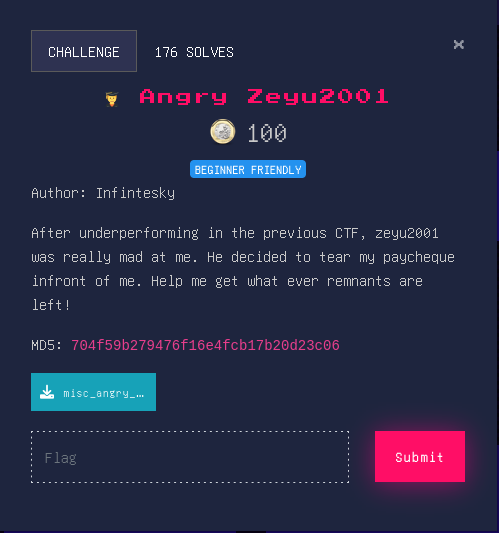
Alright, so we’ve got this situation where someone needs our help getting their paycheck back (seriously, what kind of mess did they get themselves into?). Anyway, we downloaded the files they sent us and it turned out to be a folder with over 1200 tiny JPEG images, each only 10x10 pixels in size and named with a three-digit number followed by “.jpg”. Given these details, we figured we needed to somehow sort and arrange the images to reconstruct the original picture.
So, we assumed that the first part of the name would be the x-coordinate of the small picture and the second part would be the y-coordinate. However, with no idea how to use image manipulation tools, we had to do some research and found a tool called ImageMagick. We discovered that it has a useful feature called Montage, but it took us some time to figure out how to use it. Additionally, we had a bit of trouble distinguishing between the x and y coordinates. We’ll provide you with the essential details of what we learned, so you can understand our solution.
- Based on the names and the amount of files the result picture should have 530x220 pixels. This is based on the fact that one picture is 10x10 and the naming we saw. Having this in mind this means the tile operator should be 53x22
- We looked into one picture and we don’t need any additional borders. Per default a border of 10 pixels is set by imagemagick. So we set it to +0+0.
- Same idea is true for the background. We don’t need one so none was the choice.
- The input imagemagick uses is based on the list given by bash. The files were sorted based on the x coordinate starting with 000. But Imagemagick adds picture to the right of the current picture until the column is full. After that it adds the column under the current one. But the list we get starts therefore on the bottom left instead of the top left which we need. So we have two solutions.
- Either rotate the input images 90 degree or
- sort the list based on the y coordinate starting with the top.
So having this in mind we had the following as a first solution:
./magick montage -tile 53x23 -geometry +0+0 -background none pieces/*.220.jpg pieces/*.210.jpg pieces/*.200.jpg pieces/*.190.jpg pieces/*.180.jpg pieces/*.170.jpg pieces/*.160.jpg pieces/*.150.jpg pieces/*.140.jpg pieces/*.130.jpg pieces/*.120.jpg pieces/*.110.jpg pieces/*.100.jpg pieces/*.090.jpg pieces/*.080.jpg pieces/*.070.jpg pieces/*.060.jpg pieces/*.050.jpg pieces/*.040.jpg pieces/*.030.jpg pieces/*.020.jpg pieces/*.010.jpg pieces/*.000.jpg test.jpg
Which is kind of ugly as a one liner. After some time we also realized that:
./magick montage -tile 23x53 -geometry +0+0 -background none -rotate 90 pieces/*.jpg flag.jpg
./magick convert -rotate 270 flag.jpg
Works perfectly the same and is a bit more elegant.

Weirdly the result seem still not to be perfect. But good enough to read the actual flag: SEE{boss_aint_too_happy_bout_me_9379c958d872435}
Not sure what went wrong but if you read our other write-ups then you see that we aim for good enough and not perfect (๑˃ᴗ˂)ﻭ
sniffedtraffic
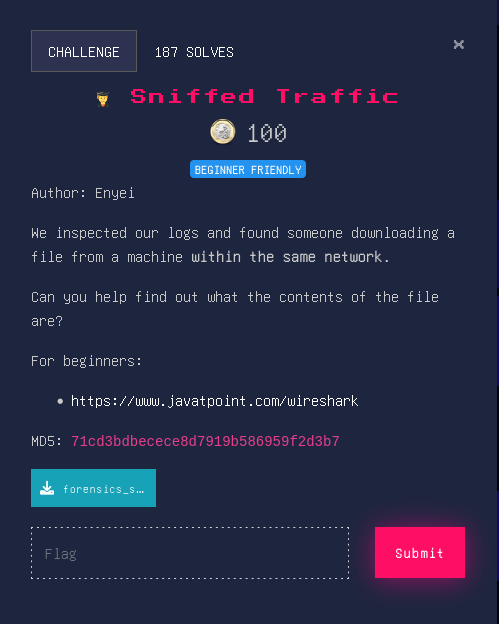
We opened the pcap file with Wireshark and found over 4,000 packets, which seemed like a lot to go through. To save time, we checked the export options to see if any useful files were there, as the description indicated that a file was downloaded via File -> Export Objects -> HTTP.
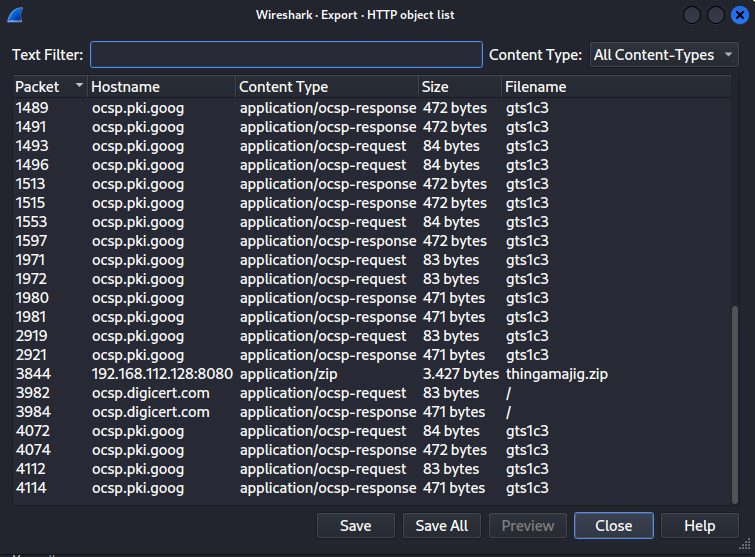
Well well, what do we see here ? a thingamajig.zip ( ͡ಠ ʖ̯ ͡ಠ) ROFL . Good start, but when we tried to unzip it we were asked for a password. Since this is considered an easy task we thought: let’s go trough the tcp streams and see if something is there.
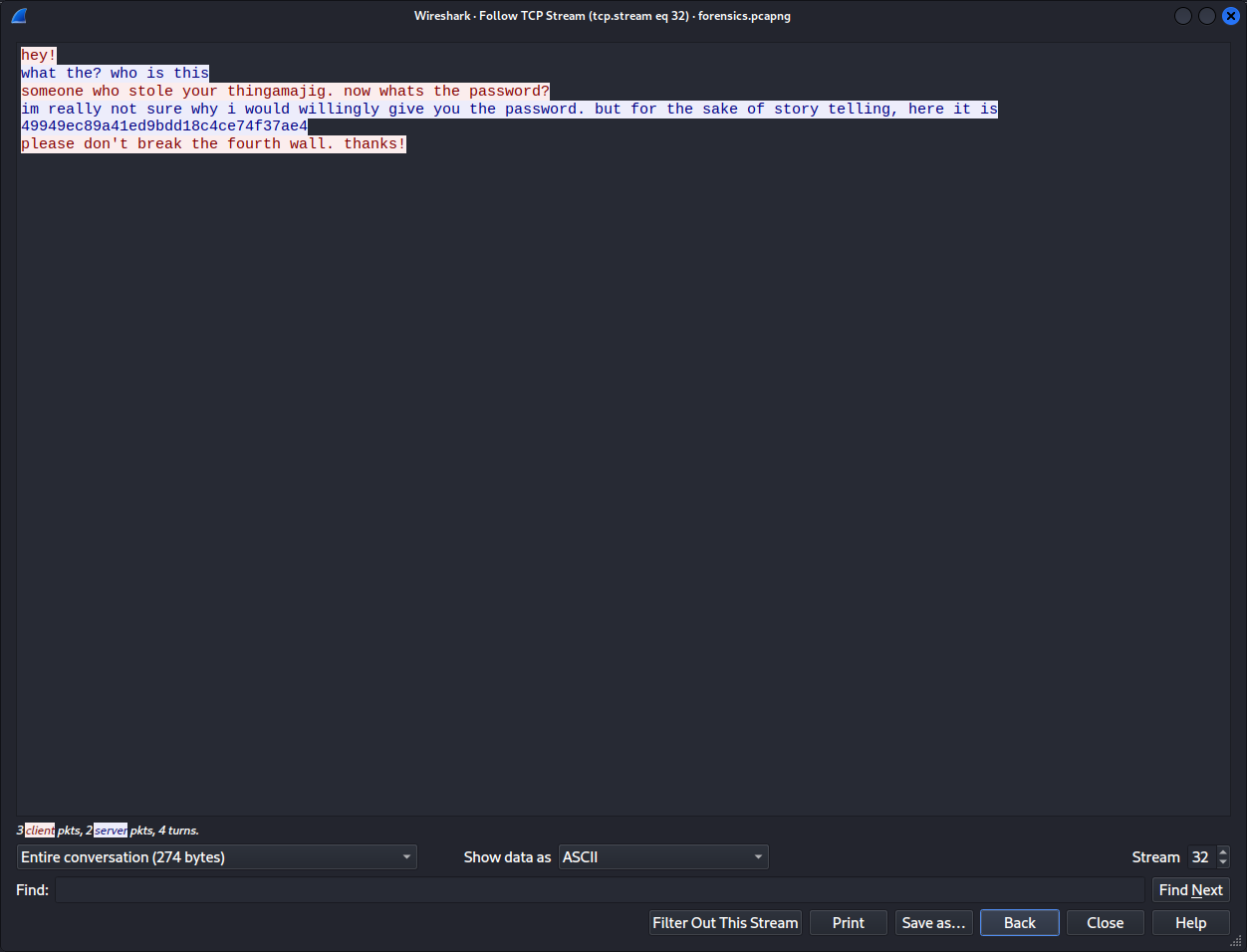
ahhhh….. Passwords in clear text with a reference to hunter2, we see what you did there. ROFL
Okay once we had that, a “stuff” file came up.
└─$ file stuff_save
stuff_save: data
Hmm so just data. When we looked into the file via a text editor we saw that strings “flag.txt” are visible. Since unzip has not worked on it we just used “foremost” to see if it finds something.
└─$ cat audit.txt
Foremost version 1.5.7 by Jesse Kornblum, Kris Kendall, and Nick Mikus
Audit File
Foremost started at Fri Jun 3 22:37:24 2022
Invocation: foremost stuff_save
Output directory: /home/kali/CTF/CTF/SEETF_CTF_2022/forensics_sniffed_traffic/output
Configuration file: /etc/foremost.conf
------------------------------------------------------------------
File: stuff_save
Start: Fri Jun 3 22:37:24 2022
Length: 3 KB (3249 bytes)
Num Name (bs=512) Size File Offset Comment
0: 00000001.zip 249 B 1000
Finish: Fri Jun 3 22:37:24 2022
1 FILES EXTRACTED
zip:= 1
------------------------------------------------------------------
We are onto something, let the hunt begin hunter2. Another zip again with a password. No further hints were found in the pcap so we tried good old brute forcing. For that we used fcrackzip. We used the good old rockyoutxt wordlist and had luck immediately :
└─$ fcrackzip -u -D -p /usr/share/wordlists/rockyou.txt 00000001.zip 130 ⨯
PASSWORD FOUND!!!!: pw == john
With that we could “unzip” again and got the flag.txt with the flag: SEE{w1r35haRk_d0dod0_4c87be4cd5e37eb1e9a676e110fe59e3}
It was a tedious task to find all these small steps but that’s what they call brain fucking ( ͡~ ͜ʖ ͡~). If you did not get all small steps don’t be sad it was tough in our opinion too.
regex101
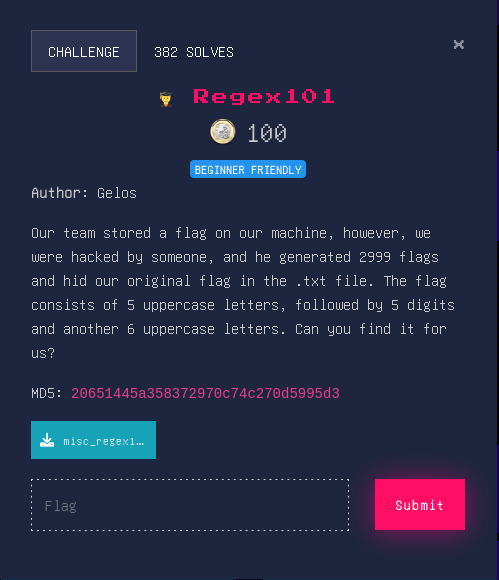
This was actually one of the challenges which did not really have something to do with hacking. This was more or less a training task to recognize that being able to use regex expressions can be crucial. Based on the name of the challenge we thought this was a hint to use the site regex101 so that’s what we did. So we “cat” the attached file to have all 2999 and copied them into regex101.
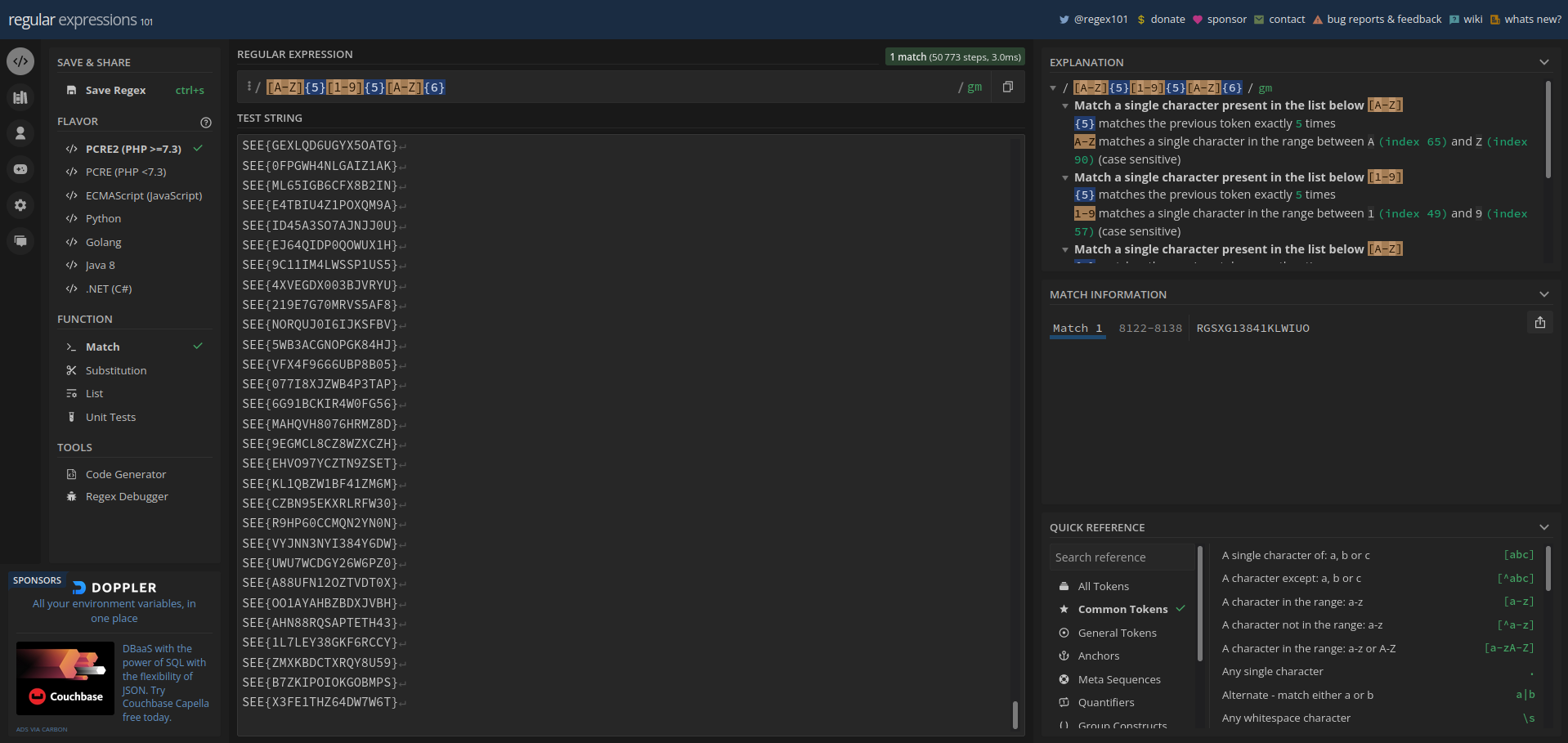
As you can see in the Screenshot we already have only one match with the regex [A-Z]{5}[1-9]{5}[A-Z]{6} which brings us the flag SEE{RGSXG13841KLWIUO}. On the right side you also have a nice explanation why this regex matches and what the single parts do. Play around a bit with it and use the references or the regex quiz on the left side to improve your regex skills.
Conclusion
We had a lot of fun with these challenges and were also able to solve the one or the other @^▽^@. We also were one of the lucky raffle winners. Thanks for that too. Overall it were also quite hard challenges. It was a good mix and we’ll see if time allows it we will be back again in 2023.